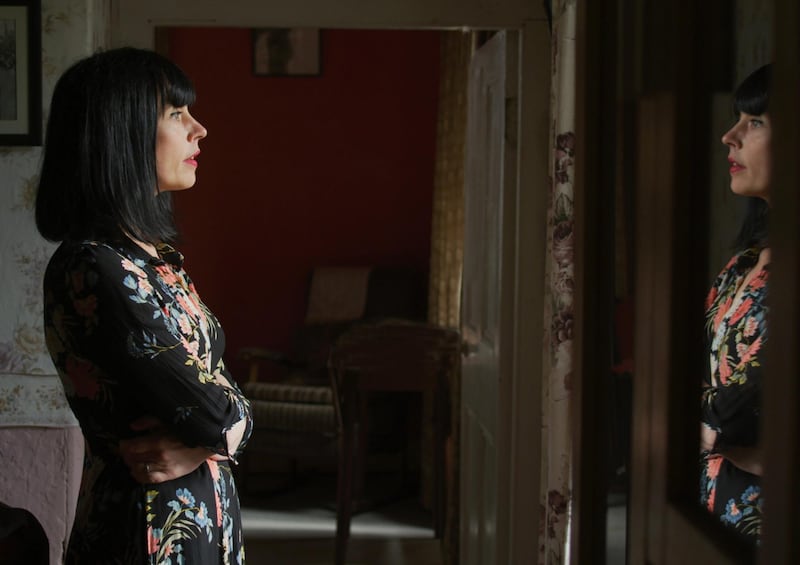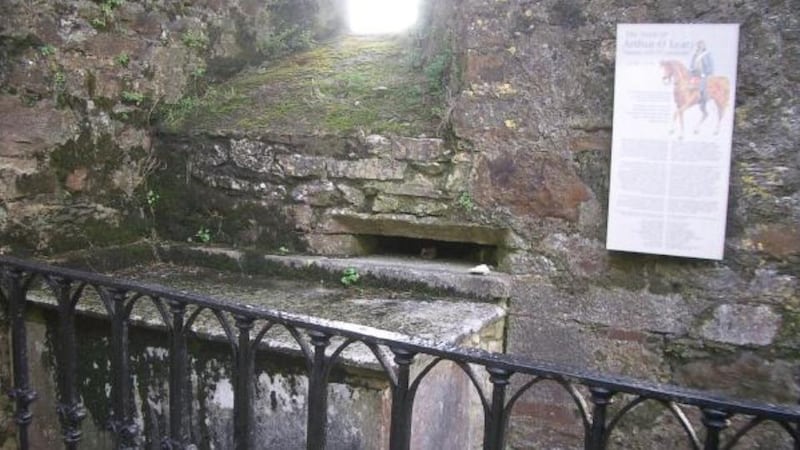A Ghost in the Throat begins with a quote from Eibhlín Dubh Ní Chonaill, the 18th-century poet whose classic lament Caoineadh Airt Uí Laoghaire provides the spine for Doireann Ní Ghríofa’s extraordinary adventure into historical reconstruction, maternal duty and womanhood.
The young, circumspect narrator of the book, who shares much in common with the author, is introduced in a swirl of household chores: checking a schoolbag, filling the dishwasher and pumping her excess breast milk to donate to premature babies. She finds companionship and an imaginative space in Eibhlín Dubh Ní Chonaill’s keen, a work Ní Ghríofa developed a “schoolgirl crush” on as an eight-year-old.
The romantic verve of Caoineadh Airt Uí Laoghaire as chronicled by the author is as infectious as the rhythms of her domestic life. Dubh Ní Chonaill was an Irish noblewoman who eloped with a Catholic husband. When he was murdered, she was already pregnant with his third child. Upon discovering his slain body, she drinks handfuls of his blood. Ní Ghríofa’s account of motherhood is equally vivid: a sprawling, startling enterprise that encompasses everything from box-ticking chores to bodily fluids.
As a literary detective – a journey recounted in the absorbing new documentary Aisling Trí Néallaibh: Clouded Reveries – Ní Ghríofa is continually frustrated by the systemic erasure of women’s voices from the canon. “How I wish that someone had thought women’s words worthy of a place in that old secretaire,” she writes. “All the diaries and letters and ledgers I imagine in female handwriting, they must have existed once, until someone tidied them into a waste bin, tipping them neatly into oblivion.” It’s a wonderful film, not least because, as Ní Ghríofa says, “it’s a remarkable woman artist looking at another woman artist looking at another woman artist.”
Perimenopausal and menopausal skin: How to tackle the most common problems
Cáit O’Riordan: ‘I quit the Pogues at 21. I got sober ... didn’t see Shane much’
Justine McCarthy: Philanderer Daniel O’Connell lies in a hero’s grave, his wife Mary in an overgrown tomb
Brianna Parkins: ‘I am Alan f***ing Sugar’: I marvel at my business acumen on DoneDeal
The result is a rewarding entanglement.
Every time I spoke this poem, I was conjuring the voice of Eibhlín Dubh Ní Chonaill. Whenever this poem is recited, in some sense, she’s alive again
“I suppose Caoineadh Airt Uí Laoghaire is such a strong part of our literary canon and our literary history,” says Ní Ghríofa. “So many people have studied it at school or researched it or translated it into English. It’s been a play and a short film over the years. When I began to become, I suppose, obsessed with it. I just began reading it over and over again, almost whispering constantly under my breath. And one day, I just had the feeling: wow, this is a poem composed hundreds of years ago. It’s miraculous that it has found its way into this generation and this century. Because it’s a work of oral literature composed by a woman.
“But the other thing I was struck by is that every time I spoke this poem, I was conjuring the voice of Eibhlín Dubh Ní Chonaill. Whenever this poem is recited, in some sense, she’s alive again. That made me feel very curious about who this woman was. Of course, being the book nerd that I am, I went straight to the library, and started checking out different translations and works of history about that era. I was really hungry for a book that would tell me everything about her, and I couldn’t find that book. I was like a treasure hunter seeking out little pieces.”

She laughs. “I was so caught up in the excitement and adventure of gathering the information, it took me a while to notice that I was researching for the book I wanted to read.”
An impossibly glamorous woman – even at 9.30 on a Friday morning – Ní Ghríofa is not, perhaps, who a casting agency might suggest for the role of academic sleuth.
The mother of three boys and one girl – Fiach, Cúán, Darach and Laoise, she’s far jollier than one might expect given the intellectual and philosophical heft of both Ghost in the Throat and her seven collections of poetry. Her urge to write, rather than being hindered by maternal duties, is a twinned enterprise, she says. A Ghost in the Throat, rather movingly, was largely composed in the author’s car, parked in a multistorey car park in Ballincollig, after she dropped her daughter to creche.
“For me, I only came to writing after having had my first child,” says the author. “I never had the experience of being a writer before I was a mother. For me, it was almost like a lifeline. It was this really exciting, almost electrifying part of my life that was developing alongside motherhood, that felt completely new and strange. That was my primary response: what’s going to happen if I follow this impulse? Where is it going to lead me? I grasped that with two hands because I needed something beyond motherhood – no, that’s not correct. But I needed something alongside the exhausting labour of parenting. And writing became that for me.
“And I feel like I’m still holding on. I can never see where I’m going to go next. That is what fascinates me about writing, sitting down in front of an open Microsoft Word. I mean, it can be frustrating. But it’s such a joy.”

Director Ciara Nic Chormaic’s Irish-language documentary Clouded Reveries carefully untangles Ní Ghríofa’s process and journey. It’s a fascinating and sometimes serpentine path.
The death of her grandfather proved a pivotal moment. Certain places, too – notably Cork and her grandmother’s house – shaped her writing. The new film features scenes from that homestead just before its demolition, a strangely definitive documentation of a dreamscape.
As a teenager, the Galway-born and Clare-raised poet initially had her sights set on dentistry. She studied anatomy and pre-med at University College Cork for a year before switching to Applied Psychiatry with Literature. Her ill-fated scientific venture informs the dazzling sixth chapter of Ghost, in which she takes part in the dissection of a body.
“My parents understood me in the way that parents understand their own kind,” recalls Ní Ghríofa. “So they were very much of the opinion that I should do an arts degree because I would be suited to that. I could study English or History. They thought I would respond really well to those subjects. But I felt that I wanted something that would culminate in a job that would be safe and have a salary. So I said, I really think dentistry will be a better option for me. And after a while, I realised that my parents had been right all along. I should be doing an arts degree. And it’s a bit embarrassing because my idea of teenage rebellion was: I’m going to be a dentist.”
A Ghost in the Throat won Book of the Year at the An Post Irish Book of the Year awards, the Foyles Non-Fiction Book of the Year award, the Hodges Figgis Irish Book of the Year award, and the £10,000 James Tait Black Prize. It was additionally named as a New York Times Notable Book of the Year and was the inspiration for many ardent, admiring reviews on social media platforms during various lockdowns. It was a cultural conversation that, due to Covid-related restrictions, excluded the author. She had no idea how big her own book was.
I had my little girl with me at the graveside, and she would mimic my reciting the poem without even knowing the words. Like she was singing a song
“The funny thing about that is that it was published so beautifully by Lisa Coen and Sarah Davis-Goff at Tramp Press,” she says. “It was published in August 2020 at the height of the pandemic. And they did such a magnificent job of publishing it. They managed to bring this book to life and to loads of readers despite everything. I had no real understanding of how many readers had found it, because there were so few people at the launch. At that time, you couldn’t have many people in a room. It was that stage of restrictions. But we had such support from bookshops up and down the country. And people found their way to it. And took it to their hearts. And I only grasped that because of the letters I received. That’s so thrilling for me. Because every letter makes me think: it’s Eibhlín Dubh. They’re responding to her life and her words just like I did.”
Ní Ghríofa describes her writing process as being rooted in the friction between two words, whether those words are in English or Irish, the language of most of her poems. A Ghost in the Throat began with a visit to Kilcrea Abbey – where Art Ó Laoghaire, the subject of Caoineadh Airt Uí Laoighaire, is buried – and an incantation of the author’s favourite poem. Those words somehow coalesced into the earworm “this is a woman’s text”, a refrain that shapes the book.
“I had my little girl with me at the graveside,” says Ní Ghríofa. “And she would mimic my reciting without even knowing the words. Like she was singing a song. And I was struck that she was learning the poem from my voice and that I only knew the poem because that exact process had happened so many other times through the years. For a long time this poem was carried by women. Long before it was ever transcribed. And now the book is being published in 16 languages, from Korean to Brazilian Portuguese. And Eibhlín Dubh’s words will appear, in Irish, at the back of each of those books. Her words are being carried to new readers all the time, all over the world.”
Aisling Trí Néallaibh: Clouded Reveries opens on November 11














